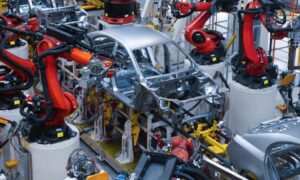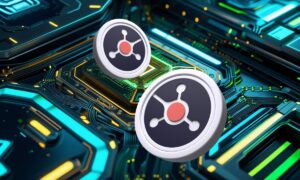NFT promises to be the next big thing in blockchain technology. While decentralized finance (DeFi) gathered most of the attention in 2020, NFT marketplaces are seeing increasing interest from enthusiasts, collectors, and even famous investors like Mark Cuban. Most of it, however, is coming from gamers.
A new game is putting together the best features from both worlds. Cometh is a blockchain game that lets users own yield-generating NFTs, integrating both DeFi and NFT features into a single, fun gaming experience. It recently launched on Polygon and featured a giveaway by NFT artist Arke as well as a 30% purchase price cash back in the game’s native $MUST ⚗️ token. We sat down with Cometh’s architect Jerome de Tychey to learn more.
First of all, what are the current opportunities you see for blockchain games?
Simply put, blockchain can very well be the sun a video game is revolving around. Assets stored in the blockchain belong to the players, fairness and transparency of the game mechanisms are hard coded in the blockchain. It’s a whole new approach with groundbreaking genres to be tried out. For example, NFT is undoubtedly the most exciting evolution for digital goods because it benefits from the digital scarcity that the blockchain brings along with proof of ownership and origin. Adding a fungible token model with an ERC20 on top of a NFT collection is the perfect tool for composability enhancements and to commoditize some aspects of the NFT. Both indie games and massively multiplayer games would be mad to miss that.
Tell us about Cometh and how you came up with the idea.
I have been a game for as long as I can remember,I collected NFT, explored the DeFi space and worked on various scaling approaches to Ethereum. I had a particular interest in bridging different layers. I wanted to have all of those concepts come together in a multiplayer game where players could collaborate or not. It became evident that the economy of the game could benefit immensely from integrated DeFi primitives and that relying on an scalability layer was an opportunity to offer cheap mutualized DeFi services to the players. The basics were there and the conclusion was that the NFT in the game would actually be yield generating which was super exciting. The mechanics came after with spaceship based NFT competing to mine tokens from asteroids.

We know playing Cometh can be a potentially profitable activity. What makes it fun though?
Winning at Cometh requires anticipation, precision and a little bit of luck if you lack the previous skills. Everything is blockchain based including of course the in game actions that need to go through as a transaction. This is where a form of randomness appears, sometimes the players want to change their position at the last second because they just realized they miscalculated the asteroid approach. To do that they cast a transaction which has to be broadcasted in the blockchain network and included in a block, this time frame becomes a matter of mining tokens from the asteroid or not. It’s mesmerizing to see thousands of players reposition themselves and collaborate with their armada. The retro designs of the spaceships are really cool thanks to the work of talented pixel artists and the game’s lore is slowly unraveling itself.
In this sense, how would you say integrating DeFi features is an improvement over other NFT-based games?
NFT are very appealing to gamers and DeFi is tying true utility to them in Cometh. I expect other games to rely on DeFi to help the sustainability of their economy while the players can get more familiar with DeFi services.
On Cometh, players strive to mine “asteroids.” How are they generated and what exactly are they mining?
The asteroids displayed in game are smart contracts that can hold any type of tokens including ERC20 and NFT. In order to dig the tokens out of the asteroids, the players must prove to the smart contract that they have a spaceship within mining range. Right now we are in a balancing phase of the game, during the first weeks a total of ~50,000 USDT worth of tokens are released on the asteroid for the players to mine (~6,000 at release week, then ~12,000, and ~12,000 again, ~20,000 finally) and the devs to calibrate the mechanisms.
When balancing will be done, the proceeds of the NFT sales will start being funnelled to asteroids but not as simple tokens. The first DeFi service in Cometh is a decentralized exchange sitting next to the game. The proceeds of the NFT sales will be used to provide the initial liquidity to the token pairs of the exchange. The resulting shares of the liquidity pools will be distributed on the asteroid for the players to mine and become the liquidity providers of Cometh’s exchange. Like any token exchange, some fees are taken out of the trades which are redistributed in game through minable asteroids. As more DeFi services become available more tokens will be available for mining.
The asteroids are also used as cross pollination between communities collaborating with Cometh. For example, there is a stunning collection of spaceships that was done with DontBuyMEME, the proceeds of the sales led to $MEME tokens collected by Cometh which will allow the listing of $MEME and the transfer of the liquidity pool shares on say, a pineapple shaped comet.
We have many similar collaborations coming. In fact, the ones with Aavegotchi and the $GHST token are now live.

How are you able to avoid the high gas fees that are currently affecting the Ethereum blockchain?
This is the hardest challenge we are facing right now. We had an ambitious release plan for new NFTs that we have prefered to slow down because the fees were getting ridiculously high. Our smart contracts are well optimized while not compromising on security, but they don’t offer transaction batching features or other tweaks to deal with 150Gwei gas prices. Some NFT projects are even financing the gas expenditures of their buyers to support user acquisition but we are not at this stage yet.
The game was deployed on the 8th of February on a blockchain scalability platform called Matic network. The transactions on this infrastructure are almost free but in order to get into the game, the spaceship owners have to deposit the NFT and other tokens on a bridge between Ethereum and Matic. This process is of course costly in gas fees but the appeal to play and mine some tokens took over. Six days after the launch we have about 50% of the spaceships in the galaxy that already migrated and are competing for tokens.
Can you explain what the Melange and Refinery are?
The Melange and Refinery are two concepts for DeFi interactions between the Ethereum mainnet or other chains offering DeFi services and the infrastructure where Cometh is deployed. Cometh has its own ERC20 token called the $MUST which players use to pay for in game interactions, the Refinery is a set of smart contracts that will allow the players to easily swap multiple tokens for $MUST. The Melange is another set of smart contracts aiming at mutualization of DeFi interactions from Cometh to Ethereum. Let’s say you want to deposit 100 DAI on Aave to get an interest rate on those tokens, at today’s gas price the transaction fees will eat about 20% of the value of your deposit. The Melange is meant to aggregate multiple deposits from Cometh users and do one single deposit thus saving gas fees for everyone. The Aave use case is only an example, all DeFi primitives need to be covered by this mutualization so that DeFi remains accessible for small wallets.
What’s next for Cometh? What should we look forward to in the coming months?
In the short run, we are going to announce a couple of partnerships with major DeFi apps, continue the game balancing and get ready for the deployment of our decentralized exchange. We are going to progressively bring more utility to the $MUST, starting with the introduction of in game perks to customize the spaceships and upgrade them. Those perks will be mintable by $MUST holders. A $MUST based governance will soon be introduced on the several parameters ruling the game and in the DeFi services. We are also cooking a little surprise involving Virtual Reality and working on another game concept for players versus players competition.



































